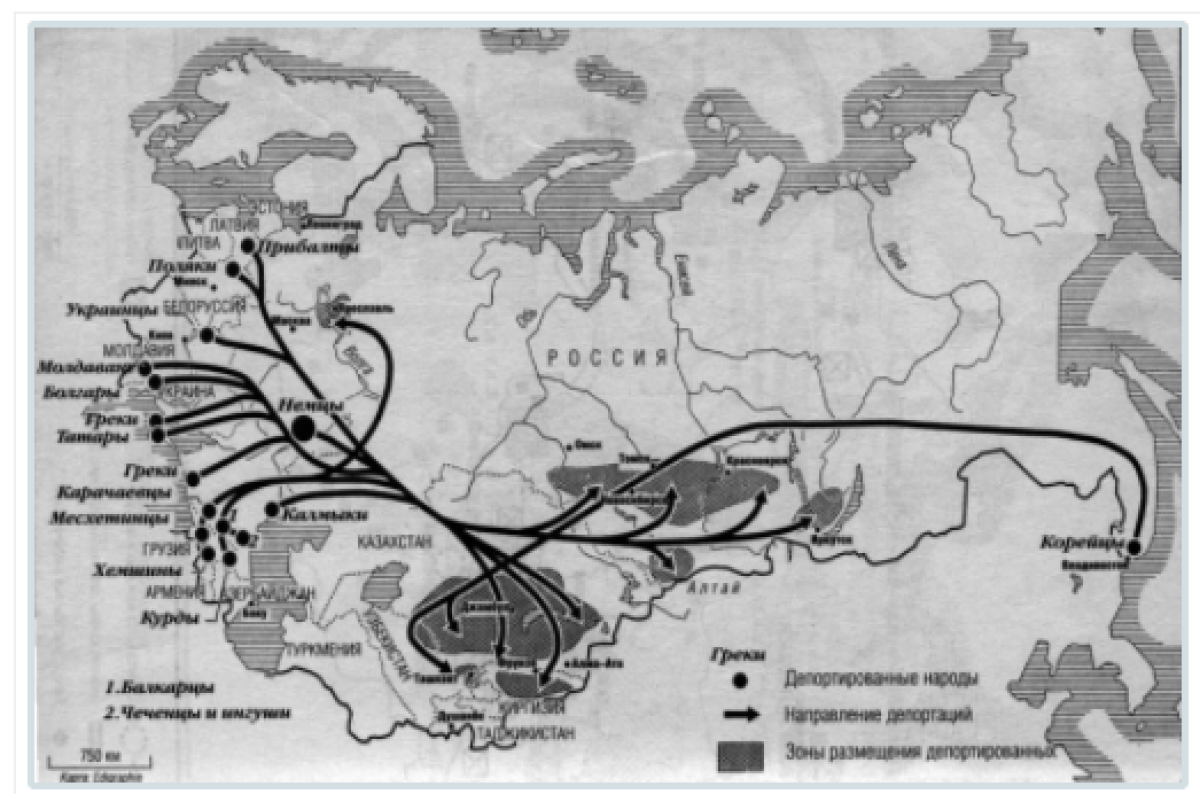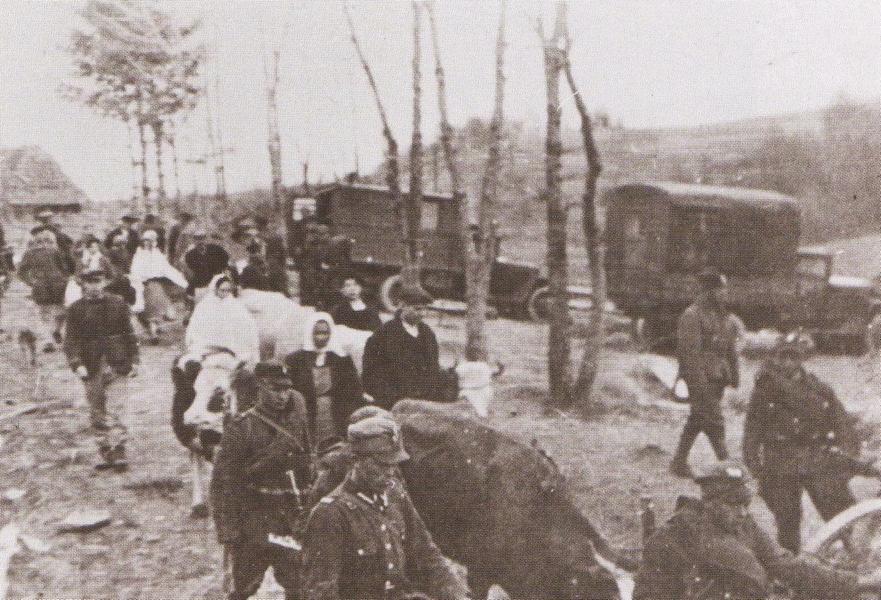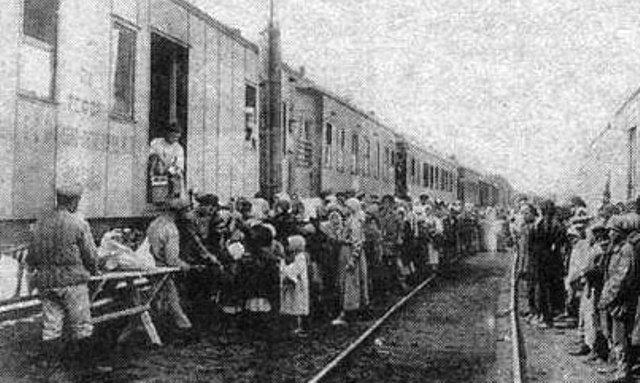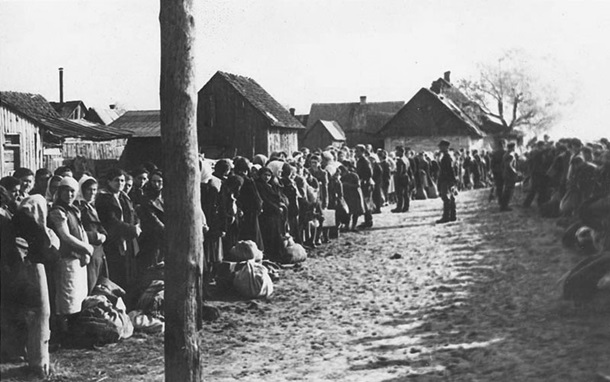
Deportation began in the prewar years. Authoritarian power of the Soviet Union began to carry out forced evictions of displeased people from settled lands. They were evicted from their native places, which were then settled by other settlers.
The deportations became an integral part of the totalitarian state system of migrations in the USSR. At the beginning of the 50s of the XX century this large-scale historical event affected at least 6 million people - about 2.5 million in the "kulak exile" and adjacent contingents, as well as about 3.5 million deported in the 1940-1952, mainly representatives of "punished peoples". This measure affected 15 peoples of the USSR and more than 60 groups of the population belonging to different nationalities.
In the years 1935-1940 military decisions dictated decisions on "cleansing" the frontier strip from the population living there, ethnically related to the peoples of neighboring countries. Repression was directed against peoples with foreign ethnic roots, connected by cultural and historical ties with border states. So, in 1936 the first Soviet total deportation of Poles and Germans took place, and then in 1937 Koreans from the Far East regions. At the same time, Kurds, Armenians and Turks were sent to Kazakhstan from the southern borders of the USSR.

After the outbreak of the Great Patriotic War in August 1941, the decree "On the Resettlement of Germans Living in the Volga Region" was promulgated. The first commune of the Germans of the Volga region was established in 1918, in 1924 it was transformed into the Autonomous SSR of the Germans of the Volga region. In 1941 it was abolished.
In May 1944, the State Defense Committee adopted a resolution on the resettlement of the Crimean Tatars, motivated by the alleged cooperation of a section of the population with fascist invaders.
In 1943-1944, representatives of the peoples of the North Caucasus were evacuated to Kazakhstan: Kalmyks, Balkars, Chechens, Ingush, Karachais, Meskhetian Turks. The fate of the settlers was tragic. A large number of them, especially women, children and the elderly, perished while on the road. Absolutely different climatic conditions awaited them and in places of new resettlement.
Evicted to the territory of Kazakhstan were in the status of special settlers. All able-bodied special settlers were required to engage in socially useful work. In January 1942, for example, all Germans from 15 to 55 years were united in labor columns, which were before the end of the war. Special resettlers did not have the right to leave the settlement area. This was seen as an escape and subject to criminal liability. Special resettlers were obliged to report to the NKVD in a three-day period all changes that had occurred in the family (birth of a child, death of a family member or escape).
An answer to the question of the duration of deportation of deported people to remote places of the settlement is given by the Decree of the Presidium of the Supreme Soviet of the USSR of November 26, 1948 "On criminal liability for escape from places of compulsory and permanent settlement of persons evicted in certain places of the Soviet Union during the Patriotic War". His preamble reads: "In order to strengthen the settlement regime for the Chechens, Karachais, Ingush, Balkars, Kalmyks, Germans, Crimean Tatars and others who were deported by the Supreme Soviet of the USSR during the Patriotic War, and also because during their relocation, the terms of their expulsion were determined, and it was established that the resettlement of the above-mentioned persons to remote areas of the Soviet Union was carried out forever, without the right to return them to their former places of residence."

The same idea is repeated in the order of the Minister of State Security of the USSR No. 00776 of October 24, 1951: "To persons of the listed categories of the German, Chechen, Kalmyk, Ingush, Balkar, Karachais, Greek and Crimean Tatars, that in accordance with the Decree of the Presidium of the Supreme Soviet of the USSR as of October 9, 1951, they were left in the special settlement forever."
Having set the goal of permanently deporting these peoples, the Soviet government chose the means of achieving it, corresponding to this goal. Severe sanctions were imposed on those who did not tolerate this goal and resisted its implementation: for unauthorized departure (escape) from the places of compulsory settlement of the said evictions, the perpetrators were subject to criminal liability with a penalty in 20 years of hard labor. Responsibility was also due to persons guilty of harboring evictions who fled from the places of compulsory settlement or facilitating their escape, persons guilty of issuing permission to evictees to return to their places of former residence, and persons who assisted them in settling them in places of former residence; the sanction and with respect to these persons was unambiguous - imprisonment for a period of 5 years.
The entire powerful punitive-repressive machine of the state was abandoned to ensure that the deportees forgot about their native lands and became accustomed to the idea of an eternal settlement in new places.
The status of special settlers was characterized by degrading procedures for registration, re-registration and marking in local commandant's offices and other NKVD or MSS agencies. With police meticulousness, every step of the special settlers was strictly regulated and tightly controlled, and it was necessary to ask for permission from the supervising authorities to perform many elementary actions.
On July 5, 1954, the Council of Ministers of the USSR adopted resolution No. 1439-649 "On the removal of certain restrictions in the legal situation of special settlers," which noted that, in connection with the changes that have occurred in the country and in the lives of special settlers, the application of restrictions to them in the legal situation is not caused by necessity. Persons who are registered with special settlements engaged in socially useful labor were granted the right to reside within this region, the territory, the republics, and on official business - the right of free movement to any point of the country on general grounds.

In order to change the existing order, a personal appearance for the special settlers was registered for registration in the Ministry of Internal Affairs once a year. The children of special settlers up to the age of 16, who were released from administrative supervision, were not taken off the records in the bodies of the Ministry of Internal Affairs, they should not be subject to the restrictions imposed on special settlers.
In the mid-fifties, the state's policy towards the deported peoples began to change. Initially, it began to soften and liberalize, and then to abandon its separate most compromising anti-legal manifestations. A striking example is the Resolution of the Central Committee of the Communist Party of Kazakhstan and the Council of Ministers of the Kazakh SSR of November 12, 1955, No. 779 "On Employment and Massive Explanatory Work among Soviet Citizens of Greek Nationality Living in the Territory of the Kazakh SSR."
On February 11, 1957, the Supreme Soviet of the USSR passed a law "On the approval of the decrees of the Presidium of the Supreme Soviet of the USSR on the restoration of the national autonomy of the Balkar, Chechen, Ingush, Kalmyk and Karachai peoples." In 1964, the long-awaited changes in the life of the German population came.
In the historical studies of the 80-90s of the XX century, for the first time, all the horrors of deportation, the tragedy of peoples who were victims of the anti-humane action of Stalinism, were considered.
Thus, in Kazakhstan in 1937-1944 more than 1 109 thousand representatives of the deported population were found, and together with evacuees - about 1,640 thousand people. In fact, in Kazakhstan, every fifth was a special settler, the republic resembled a giant GULAG.
Translated by Raushan MAKHMETZHANOVA
